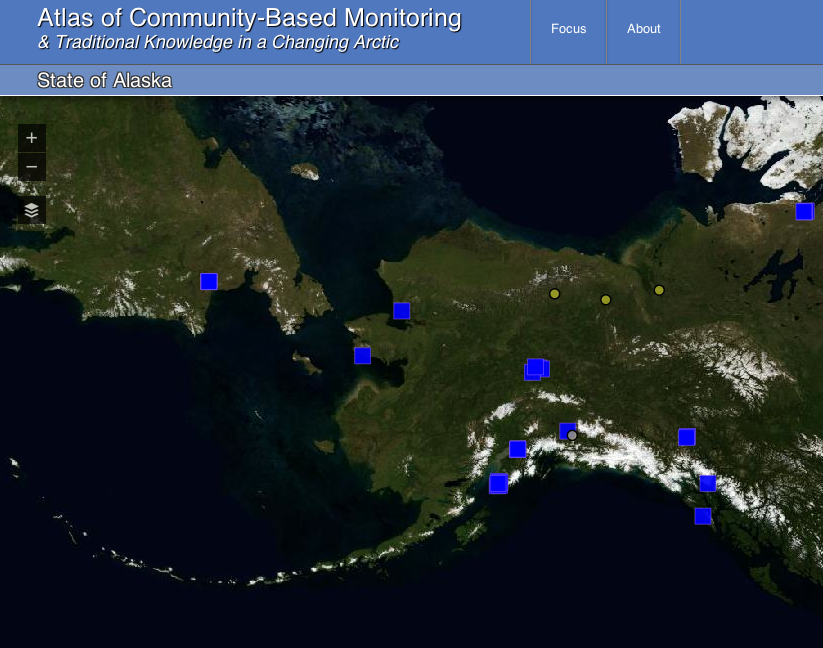 Learn about the many community-based monitoring and traditional knowledge initiatives in Alaska and other regions of the circumpolar Arctic with the Atlas of Community-Based Monitoring. The Atlas maps projects and networks around the Arctic and subarctic, displaying basic information about the different kinds of phenomena being monitored, methods used, geographic range, and time frame of monitoring. The Atlas was initiated as a task of the Sustaining Arctic Observing Networks (SAON) to help with the coordination of CBM initiatives at the circumpolar level. It is intended to serve as an inventory of initiatives that will assist with network building and identification of best practices and challenges for the field.
Learn about the many community-based monitoring and traditional knowledge initiatives in Alaska and other regions of the circumpolar Arctic with the Atlas of Community-Based Monitoring. The Atlas maps projects and networks around the Arctic and subarctic, displaying basic information about the different kinds of phenomena being monitored, methods used, geographic range, and time frame of monitoring. The Atlas was initiated as a task of the Sustaining Arctic Observing Networks (SAON) to help with the coordination of CBM initiatives at the circumpolar level. It is intended to serve as an inventory of initiatives that will assist with network building and identification of best practices and challenges for the field.
FEATURED PROGRAMS IN ALASKA
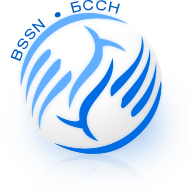 The BSSN works with local communities in western Alaska and eastern Russia to conduct community surveys and map spatial data relating to subsistence harvest and observed environmental change. It brings together researchers and local residents in co-production of science, which is place-based and relevant to the societal needs. The subsistence data is now available in the AOOS Ocean Data Explorer thanks to a partnership between BSSN and AOOS.
The BSSN works with local communities in western Alaska and eastern Russia to conduct community surveys and map spatial data relating to subsistence harvest and observed environmental change. It brings together researchers and local residents in co-production of science, which is place-based and relevant to the societal needs. The subsistence data is now available in the AOOS Ocean Data Explorer thanks to a partnership between BSSN and AOOS.
Coastal Observation and Seabird Survey Team (COASST)
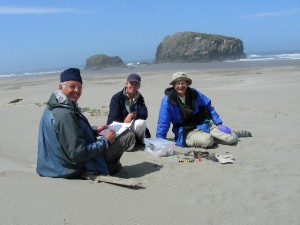
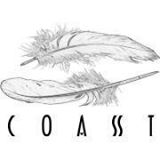 COASST sees a future in which all coastal communities contribute directly to monitoring local marine resources and ecosystem health through the establishment of a network of citizen scientists, each collecting rigorous and vital data. Data collection includes beach-cast carcasses of marine birds to establish the baseline pattern of bird mortality. The data collected helps address important marine conservation issues and protect marine resources.
COASST sees a future in which all coastal communities contribute directly to monitoring local marine resources and ecosystem health through the establishment of a network of citizen scientists, each collecting rigorous and vital data. Data collection includes beach-cast carcasses of marine birds to establish the baseline pattern of bird mortality. The data collected helps address important marine conservation issues and protect marine resources.
Cook Inletkeeper’s Citizens’ Environmental Monitoring Program
 In 1996 Cook Inletkeeper developed the Citizens’ Environmental Monitoring Program (CEMP) – to actively involve citizen volunteers in the collection and distribution of important habitat and water quality data for the Kachemak Bay and Anchor River watersheds. Cook Inletkeeper trains volunteers to collect water quality data for selected parameters that will enhance understanding of overall environmental health. Water quality information collected by citizens is managed and analyzed in a relational database, and Inletkeeper produces annual water quality reports, which provide an overview of all citizen-collected data.
In 1996 Cook Inletkeeper developed the Citizens’ Environmental Monitoring Program (CEMP) – to actively involve citizen volunteers in the collection and distribution of important habitat and water quality data for the Kachemak Bay and Anchor River watersheds. Cook Inletkeeper trains volunteers to collect water quality data for selected parameters that will enhance understanding of overall environmental health. Water quality information collected by citizens is managed and analyzed in a relational database, and Inletkeeper produces annual water quality reports, which provide an overview of all citizen-collected data.
Local Environmental Observer (LEO) Network
Local experts throughout the state are observing environmental change through the Leo Network. The LEO Network is run by the Alaska Native Tribal Health Consortium (ANTHC), and is comprised of local experts who share their knowledge and experiences to describe environmental events in their communities that are unusual or unique and locally relevant. They apply local and traditional knowledge and modern technology to share their observations and raise awareness about the changing conditions of the circumpolar north. Their observations are mapped using an interactive interface on the ANTHC website.
Sea Ice for Walrus Outlook (SIWO)
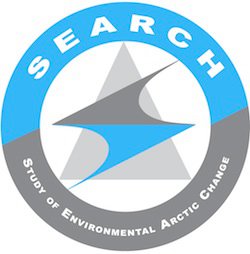
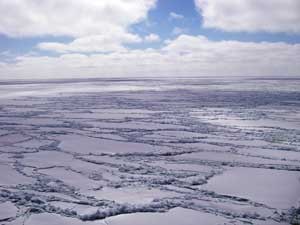 SIWO was started in 2010 as an activity of the SEARCH Sea Ice Outlook, and is a resource for Alaska Native subsistence hunters, coastal communities, and others interested in sea ice and walrus. The SIWO provides weekly reports from April through June with information on sea ice conditions relevant to walrus in the Northern Bering Sea and southern Chukchi Sea regions of Alaska. These reports are issued through the contributions of local hunters and Alaska Native sea-ice experts, weather and ice forecasters, climate scientists and sea-ice researchers at NOAA, the National Weather Service, the University of Alaska, the Arctic Research Consortium of the U.S., and the Eskimo Walrus Commission.
SIWO was started in 2010 as an activity of the SEARCH Sea Ice Outlook, and is a resource for Alaska Native subsistence hunters, coastal communities, and others interested in sea ice and walrus. The SIWO provides weekly reports from April through June with information on sea ice conditions relevant to walrus in the Northern Bering Sea and southern Chukchi Sea regions of Alaska. These reports are issued through the contributions of local hunters and Alaska Native sea-ice experts, weather and ice forecasters, climate scientists and sea-ice researchers at NOAA, the National Weather Service, the University of Alaska, the Arctic Research Consortium of the U.S., and the Eskimo Walrus Commission.
Have you seen something different, remarkable or concerning in your local environment? Check out the Alaska Sea Grant Coastal Hazards Page for information on what the top coastal hazards are and how you can respond, including who to contact and how to help – COMING SOON
Do you have an Alaska Community-Based Monitoring Program you would like to have added to this page? If so, please contact info@aoos.org

